A Longitudinal Study of the Acquisition of the Polysemous Verb 打 dǎ in Mandarin Chinese
Abstract
1. Introduction
| 1. | a. CHI (1;04): Get it. | (‘obtain’) | |||
| b. CHI (1;05): Get out. | (‘move’) | ||||
| 2. | a. CHI (1;07): | 打 | 球. | (‘play’) | |
| dǎ | qiú | ||||
| play | ball | ||||
| ‘Play with the ball.’ | |||||
| b. CHI (2;10): | 小熊 | 打死 | 它. | (‘kill’) | |
| xiǎoxióng | dǎsǐ | tā | |||
| little.bear | kill-die | it | |||
| ‘Little bear killed it.’ | |||||
1.1. Acquisition of Polysemy in Child Language
1.2. Semantics of the Mandarin Verb 打dǎ and Its Acquisition
1.3. Research Questions
- What is the developmental trajectory (i.e., emergent order) of different senses of 打 dǎ in Mandarin?
- How do Mandarin-learning children proceed in acquiring different senses of 打 dǎ in a multiple-meanings (polysemy) approach, a monosemy approach, or the restricted multiple-meanings (polysemy) approach?
- How does input, including syntactic, semantic, and contextual cues, contribute to the acquisition of different senses of 打 dǎ?
2. Materials and Methods
3. Results
3.1. Distribution and Emergence of Different Semantic Categories and Senses of 打 dǎ
3.2. Longitudinal Development of Different Senses of 打 dǎ
3.3. Comparision between Tong and His Input
4. Discussion
5. Conclusions
Author Contributions
Funding
Conflicts of Interest
References
- Adricula, Norielle, and Megan Pielke. 2019. A child’s acquisition of polysemy: Of, with, and by in child English. In Proceedings of the 43rd Boston University Conference on Language Development. Edited by Megan Brown and Brady Dailey. Somerville: Cascadilla Press, pp. 27–41. [Google Scholar]
- Allwood, Jens. 2003. Meaning potentials and context: Some consequences for the analysis of variation in meaning. In Cognitive Approaches to Lexical Semantics. Edited by Hubert Cuyckens, René Dirven and John R. Taylor. Berlin: Mouton de Gruyter, pp. 29–66. [Google Scholar]
- Booth, James R., and William S. Hall. 1995. Development of the understanding of the polysemous meanings of the mental-state verb know. Cognitive Development 10: 529–49. [Google Scholar] [CrossRef]
- Booth, James R., William S. Hall, Gregory C. Robison, and Su Yeong Kim. 1997. Acquisition of the Mental State Verb Know by 2- to 5-Year-Old Children. Journal of Psycholinguistic Research 26: 581–603. [Google Scholar] [CrossRef] [PubMed]
- Clark, Eve V. 1993. The Lexicon in Acquisition. Cambridge: Cambridge University Press. [Google Scholar]
- Clark, Eve V. 1996. Early verbs, event-types, and inflections. In Children’s Language. Edited by C. E. Johnson and J. H. V. Gilbert. Hillsdale: Lawrence Erlbaum, pp. 61–73. [Google Scholar]
- Deng, Xiangjun, and Virginia Yip. 2018. A multimedia corpus of child Mandarin: The Tong corpus. Journal of Chinese Linguistics 46: 69–92. [Google Scholar]
- Evans, Vyvyan. 2005. The meaning of time: polysemy, the lexicon and conceptual structure. Journal of Linguistics 41: 33–75. [Google Scholar] [CrossRef]
- Gao, Hong. 2001. The Physical Foundation of the Patterning of Physical Action Verbs. Ph.D. dissertation, Lund University Press, Sweden. [Google Scholar]
- Gao, Hong. 2015. Children’s early production of physical action verbs in Chinese. In The Oxford Handbook of Chinese Linguistics. Edited by William Shi-Yuan Wang and Chaofen Sun. Oxford: Oxford University Press, pp. 654–65. [Google Scholar]
- Gleitman, Lila. 1990. The structural sources of verb meanings. Language Acquisition 1: 3–55. [Google Scholar] [CrossRef]
- Goldberg, Adele. 1995. Constructions: A Construction Grammar Approach to Argument Structure. Chicago: University of Chicago Press. [Google Scholar]
- Huang, Chu-Ren, Shu-Kai Hsieh, Jia-Fei Hong, Yun-Zhu Chen, I.-Li Su, Yong-Xiang Chen, and Sheng-Wei Huang. 2010. Chinese wordnet: Design and implementation of a cross-lingual knowledge processing infrastructure. Journal of Chinese Information Processing 24: 14–23. [Google Scholar]
- Kidd, Evan. 2012. Individual differences in syntactic priming in language acquisition. Applied Psycholinguistics 33: 393–418. [Google Scholar] [CrossRef]
- Kidd, Evan, and Thea Cameron-Faulkner. 2008. The acquisition of the multiple senses of with. Linguistics 46: 33–61. [Google Scholar] [CrossRef][Green Version]
- Lakoff, George. 1987. Women, Fire, and Dangerous Things: What Categories Reveal about the Mind. Chicago: The University of Chicago Press. [Google Scholar]
- Lakoff, George, and Mark John. 1999. Philosophy in the Flesh: The Embodied Mind and Its Challenge to Western Thought. New York: Basic Books. [Google Scholar]
- Langacker, Ronald W. 1987. Foundations of Cognitive Grammar: Theoretical Prerequisites. Stanford: Stanford University Press. [Google Scholar]
- Lee, Joanne N., and Letitia R. Naigles. 2005. The input to verb learning in Mandarin Chinese: A role for syntactic bootstrapping. Developmental Psychology 41: 529–40. [Google Scholar] [CrossRef]
- Liang, Haiyan. 2014. Factors accounting for acquisition of polysemous shàng ‘to go up’-phrases in Chinese as a second language (CSL). Chinese as a Second Language Research 3: 201–25. [Google Scholar] [CrossRef][Green Version]
- MacWhinney, Brian. 2000. The CHILDES Project: Tools for Analyzing Talk. Mahwah: Lawrence Erlbaum. [Google Scholar]
- McKercher, David A. 2001. The Polysemy of with in First Language Acquisition. Ph.D. dissertation, Stanford University, Stanford, CA, USA. [Google Scholar]
- Nerlich, Brigitte, Zazie Todd, and David D. Clarke. 2003. Emerging patterns and evolving polysemies: The acquisition of get between four and ten years. In Polysemy: Flexible Patterns of Meaning in Mind and Language. Edited by Brigitte Nerlich, Zazie Todd, Vimala Herman and David D. Clarke. Berlin: Mouton de Gruyter, pp. 333–57. [Google Scholar]
- Parisien, Christopher, and Suzanne Stevenson. 2009. Modelling the acquisition of verb polysemy in children. In Proceedings of the CogSci2009 Workshop on Distributional Semantics beyond Concrete Concepts. Edited by Niels Taatgen and Hedderik van Rijn. Austin: Cognitive Science Society, pp. 17–22. [Google Scholar]
- Sak, Hui Er, and Helena Hong Gao. 2016. The Polysemy of the Chinese Action Verb “Dǎ” and Its Implications in Child Language Acquisition. In Chinese Lexical Semantics: CLSW 2016. Edited by Minghui Dong, Jingxia Lin and Xuri Tang. Cham: Springer, pp. 524–33. [Google Scholar]
- Sandra, Dominiek, and Sally Rice. 1995. Network analyses of prepositional meaning: Mirroring whose mind—The linguist’s or the language user’s? Cognitive Linguistics 6: 89–130. [Google Scholar] [CrossRef]
- 中国社会科学院词典编辑室 (Chinese Academy of Social Science Institute of Linguistics), ed. 2016. The Contemporty Dictionary of Chinese, 7th ed. (现代汉语词典 (第7版)). Beijing (北京): The Commercial Press (商务印书馆). [Google Scholar]
- Theakston, Anna L., Elena V. M. Lieven, Julian M. Pine, and Caroline F. Rowland. 2002. Going, going, gone: The acquisition of the verb ‘go’. Journal of Child Language 29: 783–811. [Google Scholar] [CrossRef] [PubMed]
- Tomasello, Michael. 1992. First Verbs: A Case Study of Early Grammatical Development. Cambridge: Cambridge University Press. [Google Scholar]
- Tuggy, David. 1993. Ambiguity, polysemy, and vagueness. Cognitive Linguistics 4: 273–90. [Google Scholar] [CrossRef]
- Vicente, Agustín, and Ingrid L. Falkum. 2017. Polysemy. In Oxford Research Encyclopedia of Linguistics. Oxford: Oxford University Press. [Google Scholar]
- Zhang, Yunqiu, Jianshe Zhou, and Jing Fu. 2010. The Acquisition Strategies of Polysemous Verbs in Early Mandarin-Learning Child Speech: A Case Study of a Child Learning the Beijing Mandarin (早期汉语儿童多义词的习得策略—一个北京话儿童的个案研究). Studies of the Chinese Language (中国语文) 334: 34–43. [Google Scholar]
- Zhang, Jiangli, Dehong Meng, and Weihong Liu. 2011. The Depth of Monosyllabic Polyseme Acquisition of Learners Who Speak Chinese as the Second Language: A Case Study of the Verb Dǎ (汉语第二语言学习者单音多义词习得深度研究一动词“‘打”为例). Applied Linguistics (语言文字应用) 2: 112–21. [Google Scholar]
| 1 | CHI = child. The age of the children is conventionally notated as years;months. Utterances are transcribed in Chinese characters and Pinyin, the official Romanized transcription of Chinese. |
| 2 | SFP = sentence final particle. |
| 3 | Examples illustrating the different senses in the child speech: hit: 打人 dǎrén ‘hit a person’; spank: 打屁股 dǎpìgǔ; open: 打开 dǎkāi; fight: 打架 dǎjià; play (ball): 打球 dǎqiú; play (game): 打牌 dǎpái; play (instrument): 打鼓 ‘play the drum’; shoot: 打枪; hold: 打伞 dǎsǎn ‘hold an umbrella’; call: 打电话; mark: 打勾 ‘mark with a tick’; knot: 打结 dǎjié ‘make a knot’; thunder strike: 打雷 dǎléi; type: 打字, ’type’; doze: 打盹 dǎdǔn ‘doze off’; sneeze: 打喷嚏 dǎpēnti ‘sneeze’; launch: 打到 dǎdào ‘launch (to)’. |
| 4 | Examples of the syntactic constructions are shown below. Basic transitive frame: e.g., 打死了七个蚊子 dǎsǐ le qi ge wénzi ‘kill LE seven mosquitos’ (I killed seven mosquitos); negative construction: e.g., 没打开 méi dǎ kāi ‘not hand.action-open’ (it did not open); modal verb constructions: e.g., 你需要打开 nǐ xūyào dǎkāi ‘you need open’ (you need to open this); ba constructions: 把那打开 bǎ nà dǎ-kāi ‘ba that hand.action-open’ (open that); bare verb compound: 打死 dǎ-sǐ ‘hit-be.dead’ (kill). |
| 5 | Examples of the syntactic frames are shown below. VV: 打死 dǎ-sǐ ‘hit-be.dead’ (kill); VNP: 打怪物 dǎ guàiwù ‘(I) shot the monster’; NPVNP: 我打妈妈 wǒ dǎ māma ‘I hit mom’; VPP: 打到上面了 ‘launch to the top’. |
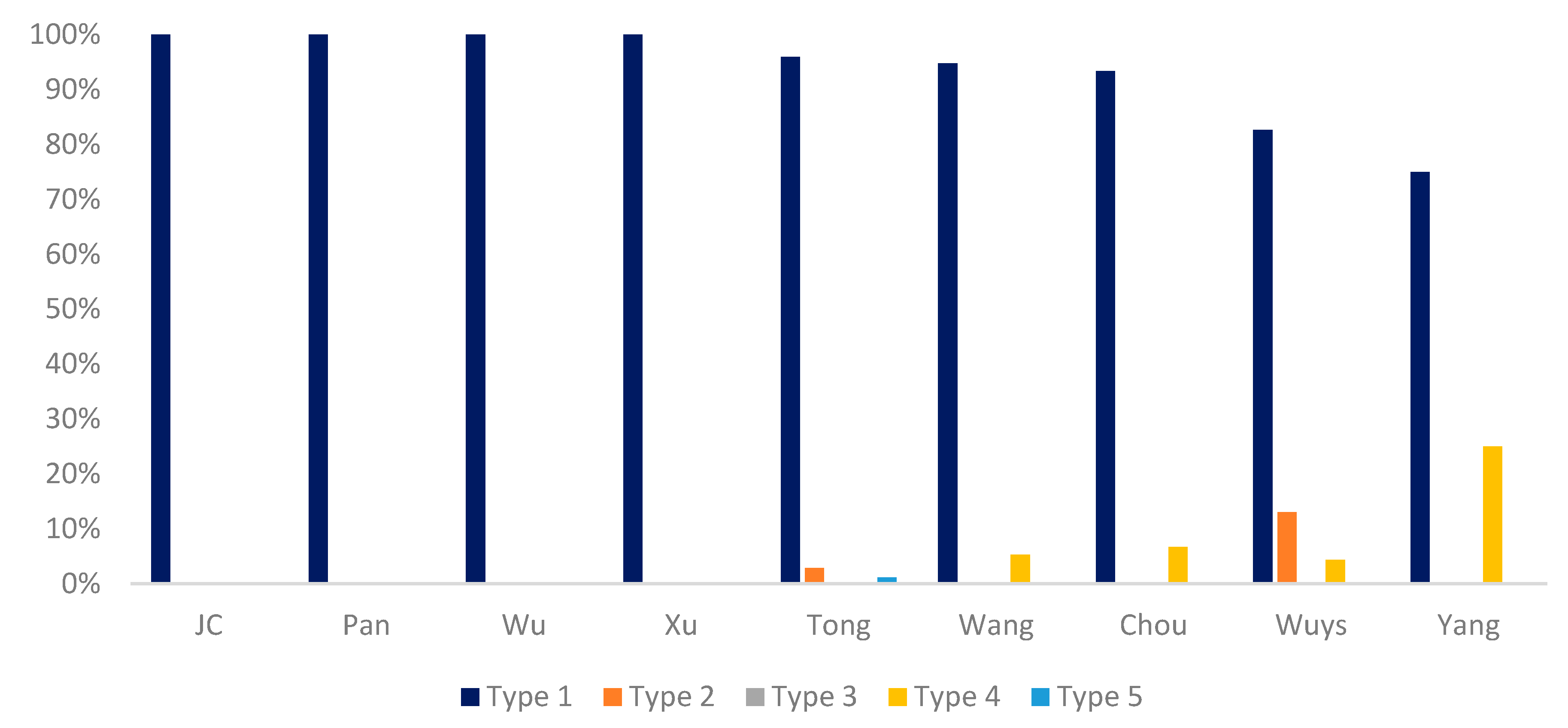
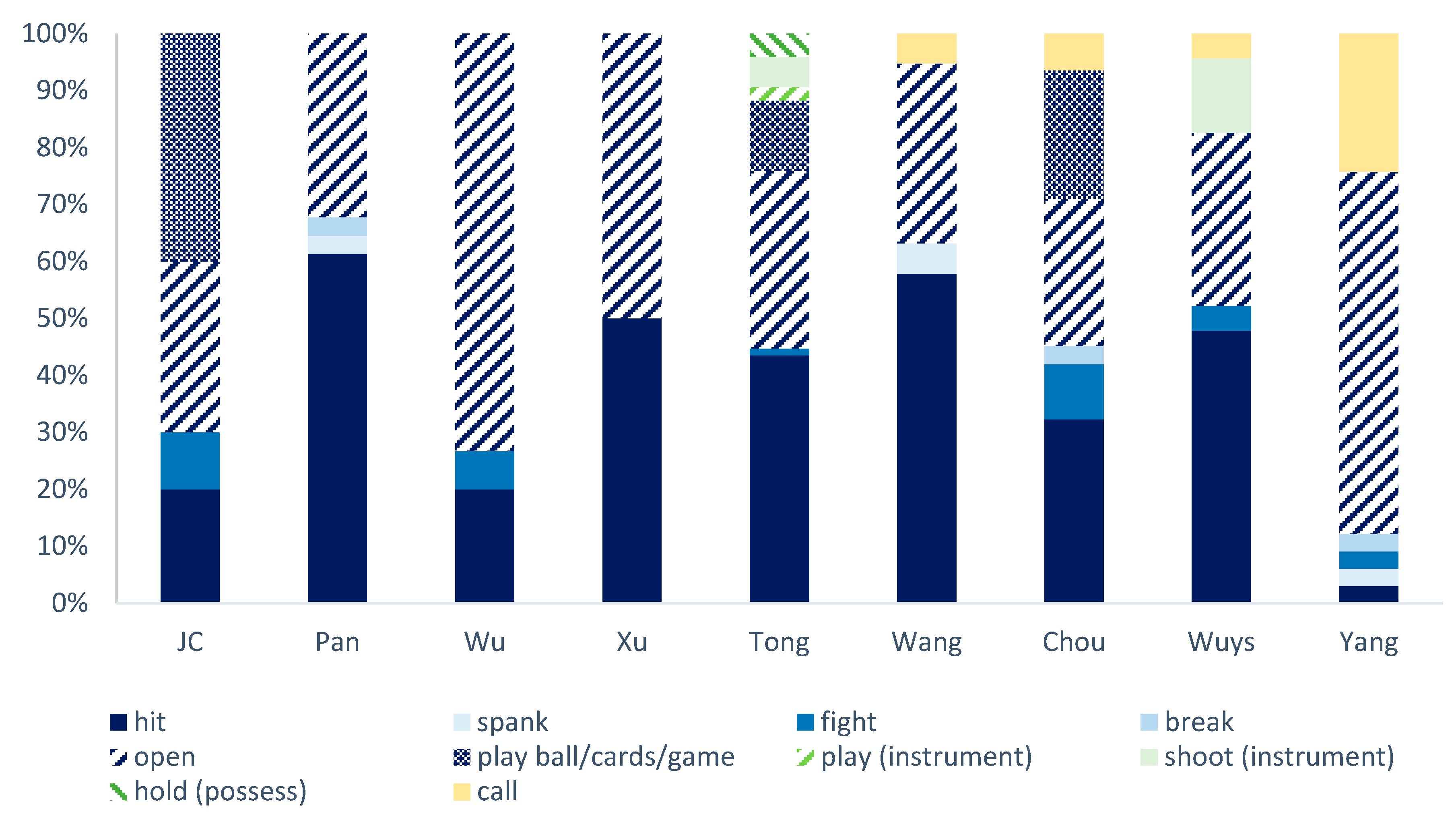

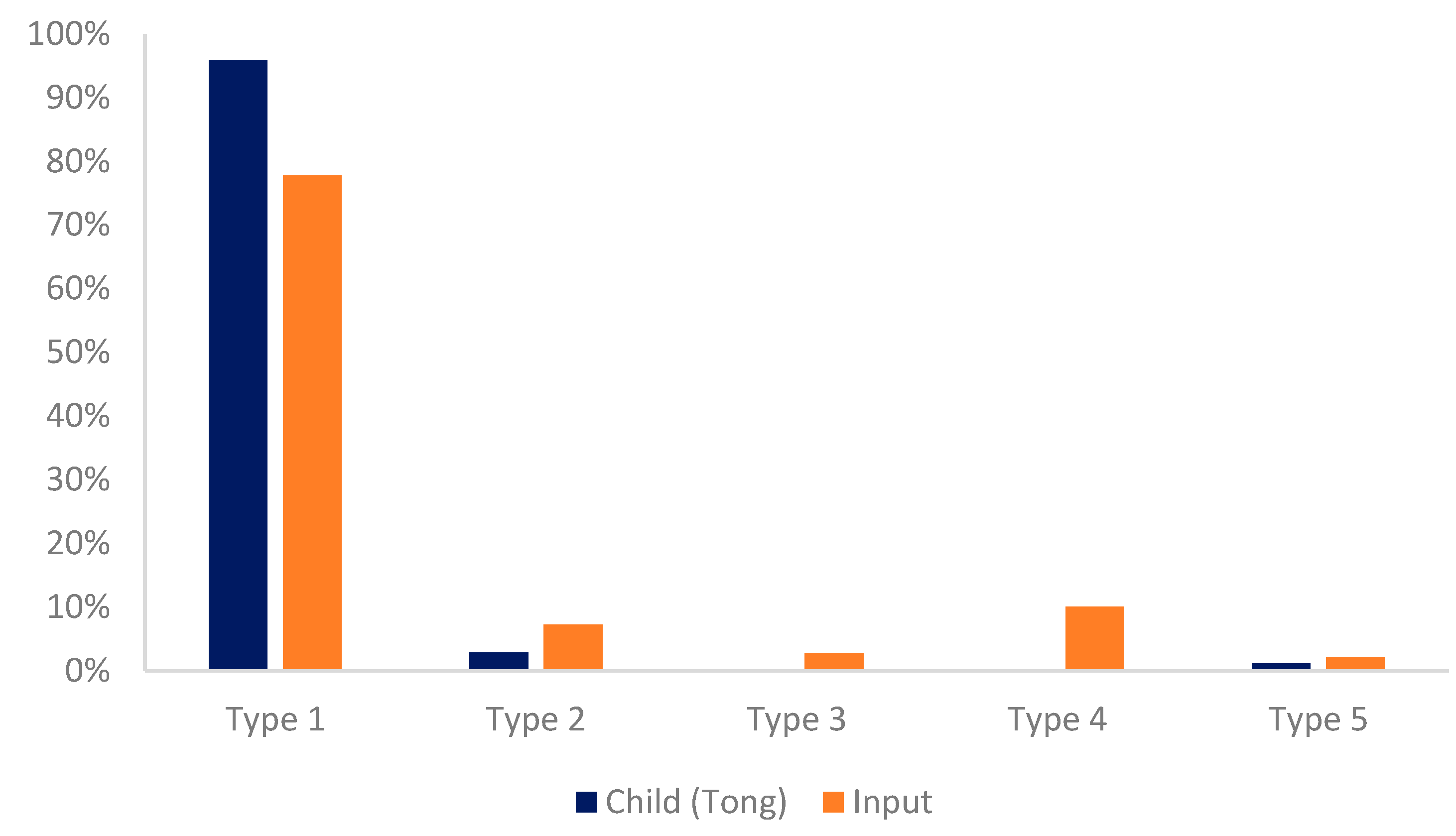
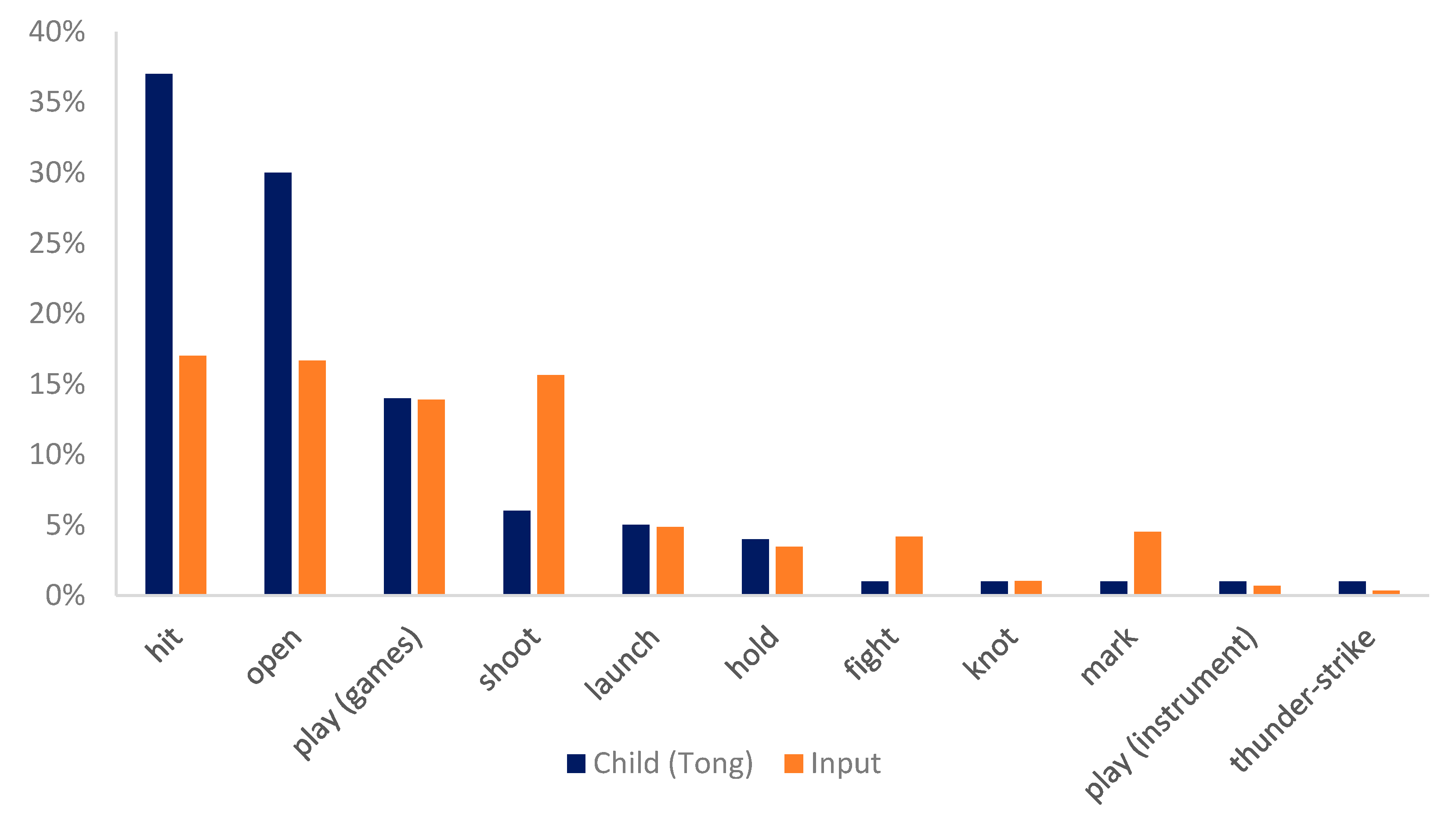
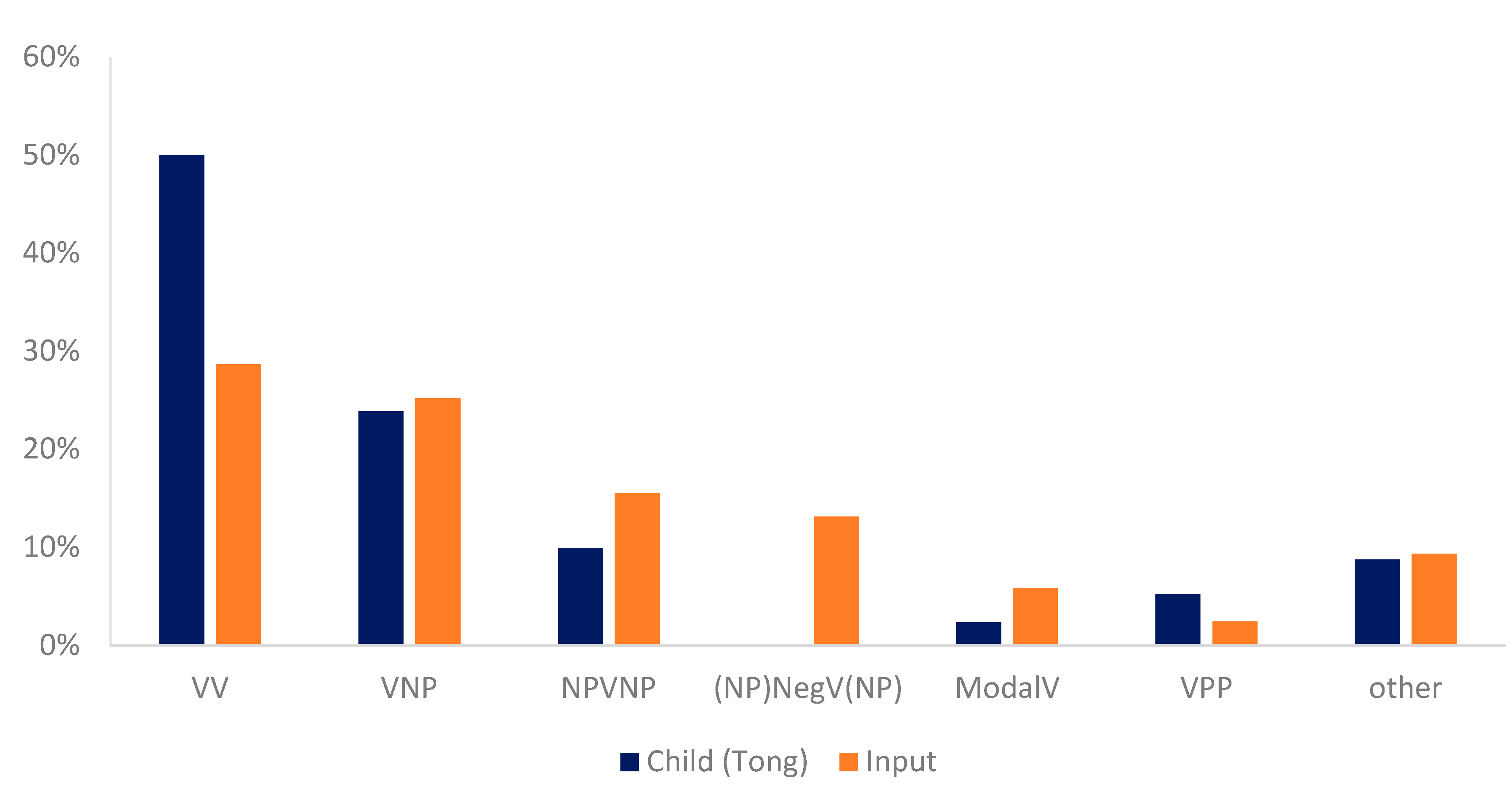
| Semantic Representations | Specific Senses |
|---|---|
| Type 1: Physical action focusing on hand contact | Defeat (play games, battle, fight, kill, attack, break, smash) |
| Physical punishment (beat, hit, punch, spank, whip, slap, strike) | |
| Open (turn on, take out, unpack) | |
| Fastening (pack up, knot, tie) | |
| Type 2: Hand action (mostly with instrument) | Construction (make, build, dig, drill, burrow) |
| Launching (shoot, fire, send, report, pump, post, set up, signal) | |
| Cover (dress up, pretend, spray, wax, powder, plaster, clout, drench, label, paint, polish, wrap) | |
| Insert (inject, nail, hammer, knock) | |
| Possess (fetch, catch, have, hunt, ladle, hold) | |
| Mark (type, work out, engrave, press, label, print, stamp) | |
| Sound source (drum, knock, cap, pound, crow, flap, ring, tap, whistle) | |
| Motion (stir, return, move, mix) | |
| Reflection (flash, reflect) | |
| Collection (gather, reap, sweep, get in, get) | |
| Removal (prune, peel, knock out, get rid of, rob, thresh) | |
| Engagement (work) | |
| Type 3: Physical action with physical contact unspecified | Physiological reaction (shiver, yawn, doze off, snore, sneeze, cheer up, hiccup, nod, stupefy) |
| Gymnastic feat (roll, tumble, loop) | |
| Posture (bare, remain, zazen) | |
| Type 4: Metaphorical uses (hand action traceable) | Social interaction (call, contact with, gesticulate) |
| Business deal (discount, buy, invest) | |
| Authoritative conduct (issue, score) | |
| Legal activity (go to court) | |
| Type 5: Metaphorical uses (hand action untraceable) | Mental activity (plan, seek, make, think of, calculate, disturb, consider, decide, draw analogy, concern, estimate) |
| Verbalization (ask about, greet, bet, draw, interrupt, talk, chat, cry out, discuss, question, speak) | |
| Opposition (defend, protest) | |
| Visual contact (meet, bump into, look at) |
| Child | Age Range | # Files | # Utterances | Types | Tokens | Token Freq. of 打 dǎ in child Speech | Token Freq. of 打 dǎ in Input | |
|---|---|---|---|---|---|---|---|---|
| 1 | Tong | 1;07–3;04 | 22 | 9110 | 5240 | 30,798 | 175 | 294 |
| 2 | Chou | 2;01–3;04 | 16 | 4991 | 1482 | 14,025 | 33 | 44 |
| 3 | JC | 2;02–3;05 | 14 | 4955 | 1183 | 10,710 | 22 | 90 |
| 4 | Pan | 1;07–3;09 | 19 | 2661 | 942 | 7634 | 40 | 129 |
| 5 | Wang | 2;05–3;04 | 12 | 3149 | 1092 | 10,133 | 19 | 44 |
| 6 | Wu | 1;07–2;01 | 12 | 2785 | 922 | 7030 | 15 | 92 |
| 7 | Wuys | 2;07–3;10 | 10 | 1396 | 758 | 5223 | 23 | 40 |
| 8 | Xu | 1;06–2;05 | 11 | 2700 | 651 | 4315 | 14 | 7 |
| 9 | Yang | 1;05–2;09 | 13 | 1929 | 733 | 4787 | 34 | 69 |
| Total | 375 | 809 |
| Child Age | Samples | Pinyin | Glossing | Translation |
|---|---|---|---|---|
| 1;07.18 | 打开啦。 | dǎkāla | hit open SFP | ‘Opened!’ |
| 1;07.18 | 打球。 | dǎqiú | play ball | ‘Play with the ball.’ |
| 1;08.22 | 打牌。 | dǎpái | play card | ‘Play cards.’ |
| 1;11.21 | 打妈妈。 | dǎmāma | hit mommy | ‘Hit mommy.’ |
| 2;00.19 | 打锣了。 | dǎluó | play gong SFP | ‘Play the gong.’ |
| 2;00.19 | 妈妈给打开。 | māmagěi dǎkāi | mommy give hit-open | ‘Mommy open (for me).’ |
| 2;01.17 | 我们来打牌。 | wǒménlái dǎ pái | we come play card | ‘Let’s play cards.’ |
| Senses\Age | 1;07 | 1;08 | 1;11 | 2;00 | 2;01 | 2;02 | 2;03 | 2;05 | 2;06 | 2;07 | 2;09 | 2;10 | 3;01 | 3;03 | 3;04 | Total | prop. |
|---|---|---|---|---|---|---|---|---|---|---|---|---|---|---|---|---|---|
| hit (person/object) | 0 | 0 | 7 | 2 | 4 | 0 | 6 | 5 | 3 | 4 | 1 | 31 | 0 | 0 | 1 | 64 | 37% |
| open | 1 | 0 | 4 | 1 | 1 | 1 | 0 | 0 | 0 | 0 | 0 | 22 | 13 | 6 | 3 | 52 | 30% |
| play (games) | 2 | 2 | 0 | 0 | 11 | 0 | 8 | 0 | 0 | 0 | 0 | 0 | 0 | 0 | 2 | 25 | 14% |
| shoot | 0 | 0 | 4 | 0 | 0 | 0 | 0 | 1 | 1 | 0 | 0 | 0 | 0 | 0 | 4 | 10 | 6% |
| launch | 0 | 0 | 2 | 0 | 0 | 1 | 4 | 0 | 2 | 0 | 0 | 0 | 0 | 0 | 0 | 9 | 5% |
| hold | 0 | 0 | 0 | 0 | 7 | 0 | 0 | 0 | 0 | 0 | 0 | 0 | 0 | 0 | 0 | 7 | 4% |
| fight | 0 | 0 | 0 | 0 | 0 | 0 | 0 | 0 | 0 | 2 | 0 | 0 | 0 | 0 | 0 | 2 | 1% |
| play (instrument) | 0 | 0 | 0 | 2 | 0 | 0 | 0 | 0 | 0 | 0 | 0 | 0 | 0 | 0 | 0 | 2 | 1% |
| knot | 0 | 0 | 0 | 0 | 0 | 0 | 0 | 0 | 0 | 0 | 0 | 0 | 0 | 2 | 0 | 2 | 1% |
| thunder strike | 0 | 0 | 0 | 0 | 1 | 0 | 0 | 0 | 0 | 0 | 0 | 0 | 0 | 0 | 0 | 1 | 1% |
| mark | 0 | 0 | 0 | 0 | 0 | 0 | 0 | 0 | 1 | 0 | 0 | 0 | 0 | 0 | 0 | 1 | 1% |
| Age/Child | Tong | Yang | Xu | Pan | Wu | Chou | JC | Wang | Wuys |
|---|---|---|---|---|---|---|---|---|---|
| 1;06 | sneeze (1) | ||||||||
| 1;07 | open (1), play (2) | ||||||||
| 1;08 | play (2) | open (2) | |||||||
| 1;09 | open (4) | open (1) | |||||||
| 1;10 | call (3) | hit (3) | |||||||
| 1;11 | hit (7), open (4), shoot (4), launch (2) | ||||||||
| 2;0 | hit (2), open (1), play instrument (2), | open (4) | hit (1) | open (1) | |||||
| 2;01 | hit (4), open (1), play (11), hold (7), thunder strike (1) | hit (1) | open (1) | ||||||
| 2;02 | open (1), launch (1), | break (1), call (1) | type (1) | hit (1), spank (1) | open (1), play (1) | ||||
| 2;03 | hit (6), play (8), launch (4) | open (1) | fight (1), call (2), open (2) | play (1) | |||||
| 2;04 | fight (1), hit (1) | hit (2) | open (3) | ||||||
| 2;05 | hit (5), shoot (1) | open (3) | open (1) | hit (1) | |||||
| 2;06 | hit (3), shoot (1), launch (2), mark (1) | open (15) | hit (2) | fight (1), open (1) | hit (2) | open (1) | hit (2) | ||
| 2;07 | hit (4), fight (2) | hit (1) | open (4) | open (2) | hit (1) | hit (3) | |||
| 2;08 | call (4), open (2), spank (1) | hit (2) | open (1), spank (1), hit (2), doze (1) | open (3), hit (6), fight (1) | |||||
| 2;09 | hit (1) | turn on (1) | |||||||
| 2;10 | hit (31), open (22), | hit (1) | hit (1), fight (2) | call (1), hit (2), hold (1) | |||||
| 3;0 | hit (7), open (1) | hit (2), play (4), break (1), open (1), sneeze (1) | hit (1) | shoot (1) | |||||
| 3;01 | open (13) | fight (2) | |||||||
| 3;02 | knot (2) | break (2), hit (2) | open (1), play (1) | call (1), hit (1) | |||||
| 3;03 | open (4), hit (1) | sweep (1) | hit (3) | open (5) | shoot (3) | ||||
| 3;04 | hit (1), open (3), play (2), shoot (4) | open (1) | play (4), hit (4) | sweep (1), play (6) | |||||
| 3;09 | hit (2), open (1) | ||||||||
| 3;10 | open (3) |
© 2020 by the authors. Licensee MDPI, Basel, Switzerland. This article is an open access article distributed under the terms and conditions of the Creative Commons Attribution (CC BY) license (http://creativecommons.org/licenses/by/4.0/).
Share and Cite
Chen, J.; Wang, X. A Longitudinal Study of the Acquisition of the Polysemous Verb 打 dǎ in Mandarin Chinese. Languages 2020, 5, 23. https://doi.org/10.3390/languages5020023
Chen J, Wang X. A Longitudinal Study of the Acquisition of the Polysemous Verb 打 dǎ in Mandarin Chinese. Languages. 2020; 5(2):23. https://doi.org/10.3390/languages5020023
Chicago/Turabian StyleChen, Jidong, and Xinchun Wang. 2020. "A Longitudinal Study of the Acquisition of the Polysemous Verb 打 dǎ in Mandarin Chinese" Languages 5, no. 2: 23. https://doi.org/10.3390/languages5020023
APA StyleChen, J., & Wang, X. (2020). A Longitudinal Study of the Acquisition of the Polysemous Verb 打 dǎ in Mandarin Chinese. Languages, 5(2), 23. https://doi.org/10.3390/languages5020023






